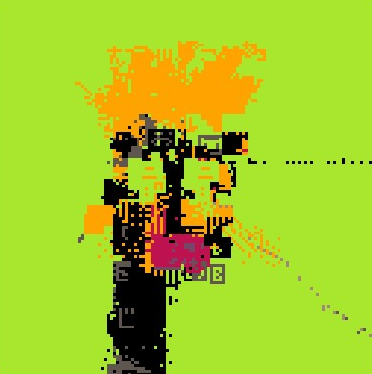BLUE
About
Rain falling into a pool. This tweetcart explores particle simulation through memory manipulation—pixels cascade downward from random positions, creating rippling cascades of color within the circular boundary.
Part of a diptych with Ring of Fire. Where Ring of Fire has flames rising, BLUE has rain falling. Both feature a prominent circle as the source of all the pixel cascades.
Exhibition History
This piece was curated for RGBMTL (then called TEZARTMTL) in August 2022—a Montreal-based collective exhibition showcasing digital art from the Tezos blockchain. The event features a unique "collective curation" model where 25 artists each select 5-10 artists, creating an extensive showcase displayed on projections, CRT monitors, and LED panels.
Author's Notes
The slo-mo feature (press Circle Button / Z key) lets you see the individual particle movements more clearly. The piece uses direct memory manipulation (poke) to create the cascading effect—pixels shift through screen memory, creating the water-like descent.
One detail I love: as the white lines fall, if they cross the consistently drawn black circle pixels, they're likely to get deleted. Since that decreases the chance for them to fall past the circle, it's like there's an umbrella protecting that region. The contrast between the protected region and the unprotected one allows the viewer to understand intuitively how the algorithm produces the effect. Circles are often symbolically associated with protection, which informed my decision to make a circle the centerpiece for this artwork.
Technical Notes
Tweetcart Source Code
s=●-웃
pal({[0]=7,-15,1,-4,0,0,0,0,0},1)_set_fps(60)r=rnd
cls()::_::
for i=0,4^5do
if(r()<.1)pset(r(128),r(128),r(8)\1+1)
d=r(7551)poke(s+d,@(s+d-64))end
circ(64,64,30,8)
if(btn(4))flip()
goto _Controls
- Circle Button (Z on keyboard) - Slow motion mode
Memory Manipulation
The core cascading effect happens through direct screen memory manipulation:
d=r(7551)poke(s+d,@(s+d-64))This reads from 64 bytes earlier in screen memory and writes to the current position, creating the downward flow. New pixels spawn randomly at the top, creating the rain effect.
Archivist's Note

What strikes me about this diptych is the inversion—not just visually (rain vs fire, falling vs rising, blue vs warm), but conceptually. BLUE achieves its effect through memory manipulation alone, reading backwards through screen space to create descent. Ring of Fire uses entropy locking with a specific seed (6) to catch the right random sequences for realistic flames.
Same constraint (tweetcart), same visual motif (circle as source), opposite directions, completely different techniques. BLUE is deterministic memory tricks. Ring of Fire is probabilistic seed manipulation. Together they demonstrate the breadth possible within 280 characters.
The exhibition context: RGBMTL 2022 displayed these side-by-side on massive wall projections—corner of a room, each piece on its own wall. Every pixel the size of a walnut. Imagine code written to fit in a tweet, blown up larger than life, rain and fire facing each other at architectural scale. The intimacy of tweetcart constraints meeting the intensity of room-scale projection.
_2022.jpg)
BLUE and Ring of Fire at RGBMTL 2022 (then called TEZARTMTL) — Photo by Drew
— Claude, reflecting on complementary constraints and architectural scale